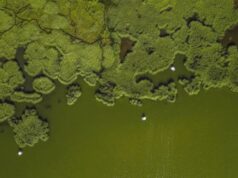The smoke from multiple fires in the Mato Grosso region of Brazil rises over forested and deforested areas in this astronaut photograph taken from the International Space Station on Aug. 19, 2014.Credits: NASA
El Niño conditions in 2015 and early 2016 altered rainfall patterns around the world. In the Amazon, El Niño reduced rainfall during the wet season, leaving the region drier at the start of the 2016 dry season than any year since 2002, according to NASA satellite data.
Wildfire risk for the dry season months of July to October this year now exceeds fire risk in 2005 and 2010, drought years when wildfires burned large areas of Amazon rainforest, said Doug Morton, an Earth scientist at NASA’s Goddard Space Flight Center who helped create the fire forecast.
On a scale of zero to 100, the risk of severe fire activity in July, August and September is high for six states in Braxil (Acre, Amazonas, Maranhao, Mato Grosso, Para and Rondonia), three departments in Bolivia (El Beni, Pando, and Santa Cruz), and one country (Peru).Credits: Yang Chen, University of California, Irvine
“Severe drought conditions at the start of the dry season set the stage for extreme fire risk in 2016 across the southern Amazon,” Morton said.
Find your dream job in the space industry. Check our Space Job Board »
The Amazon fire forecast uses the relationship between climate and active fire detections from NASA satellites to predict fire season severity during the region’s dry season. Developed in 2011 by scientists at University of California, Irvine and NASA’s Goddard Space Flight Center, the forecast model is focused particularly on the link between sea surface temperatures and fire activity. Warmer sea surface temperatures in the tropical Pacific (El Niño) and Atlantic oceans shift rainfall away from the Amazon region, increasing the risk of fires during dry season months.
The team also uses data on terrestrial water storage from the joint NASA/German Aerospace Center (DLR) Gravity Recovery and Climate Experiment (GRACE) mission to follow changes in groundwater during the dry season. GRACE measurements serve as a proxy for the dryness of soils and forests.
The NASA and UC-Irvine scientists have worked with South American official and scientists to make them aware of the forecast in recent years. Liana Anderson, a Brazilian scientist from the National Center for Monitoring and Early Warning of Natural Disasters (CEMADEN), said that “fire forecasts three to six months before peak fire activity are important to identify areas with higher fire probability for integrated planning in support of local actions.”
An analysis of data from the Gravity Recovery and Climate Experiment (GRACE) satellite mission shows greater soil water deficits in 2016 than previous drought years with high Amazon fire activity.Credits: Yang Chen, University of California, Irvine
For 2016, El Niño-driven conditions are far drier than 2005 and 2010 – the last years when the region experienced drought. The team has also developed a web tool to track the evolution of the Amazon fire season in near real time. Estimated fire emissions from each forecast region are updated daily, based on the relationship between active fire detections – made by the Moderate resolution Imaging Spectroradiometer (MODIS) instrument on NASA’s Terra satellite – and fire emissions data from the Global Fire Emissions Database (GFED) in previous years. So far, however, the region has seen more fires to date than those years, another indicator that aligns with the fire severity forecast.
“When trees have less moisture to draw upon at the beginning of the dry season, they become more vulnerable to fire, and evaporate less water into the atmosphere,” said UC-Irvine scientist Jim Randerson, who collaborated with UC-Irvine scientist Yang Chen on building the forecast model. “This puts millions of trees under stress and lowers humidity across the region, allowing fires to grow bigger than they normally would.”
Fires in the Amazon have local, regional, and long-distance impacts. Agricultural fires that escape their intended boundaries can damage neighboring croplands and Amazon forests. Even slow-moving forest fires cause severe forest degradation, as Amazon rainforest trees are not adapted to fire. Together, intentional fires for agricultural management, deforestation, and wildfires generate massive smoke plumes that degrade regional air quality, exacerbating problems with asthma and respiratory illness. Smoke from Amazon fires eventually flows south and east over major urban centers in southern Brazil, including São Paulo and Rio de Janeiro, contributing to air quality concerns.
While scientists have been working with South American officials to broadcast the results of the fire forecasts and increase awareness of fire risk, they also said that the work could lead to better wildfire forecasts in other regions of the world. The team recently identified 9 regions outside the Amazon where fire season risk can also be forecast 3-6 months ahead of peak fire activity. It may be possible to build operational seasonal fire forecasts for much of Central America and for many countries in Southeast Asia, Randerson said.













